Professor Virchow’s Iron Bitters – Chicago
04 September 2015 (R•120615)
![]() Jeff Burkhardt (Cedarburg, Wisconsin) sent the following e-mail and two pictures of a Professor Virchow’s Iron Bitters. I have not seen one of these bottles before so I thought this was pretty cool. Nice to see that Jeff took the time to find out a little bit about the bottle.
Jeff Burkhardt (Cedarburg, Wisconsin) sent the following e-mail and two pictures of a Professor Virchow’s Iron Bitters. I have not seen one of these bottles before so I thought this was pretty cool. Nice to see that Jeff took the time to find out a little bit about the bottle.
Hello Ferdinand,
Just picked up a PROF. VIRCHOW’S IRON BITTERS, a bitters that I’d never seen before. A quick search reveals that HERMAN KAESTNER was a pioneer tobacco merchant and possible saloon owner(609 Wells St.) in CHICAGO in late 1890s.
The bottle, V-23 in the Ham/Ring listing, is rated extremely rare and came from an old Wisconsin collection. Carlyn listed in her FOR BITTERS ONLY so she may have had one. This is what makes bitters collecting so exciting…always a new, extremely rare find around the corner!
Froggy
The Carlyn Ring and W.C. Ham listing in Bitters Bottles is as follows:
V 23 PROFESSOR VIRCHOW’S IRON BITTERS
PROF. VIRCHOW’S /IRON BITTERS / MAN’FRD BY THE / CHICAGO BITTERS CO. / HERMAN KAESTNER / SOLE AGENT // f // f // f //
6 3/4 x 3 (5 1/4)
Square, Amber, CM, Extremely rare
Lettering reads base to shoulder
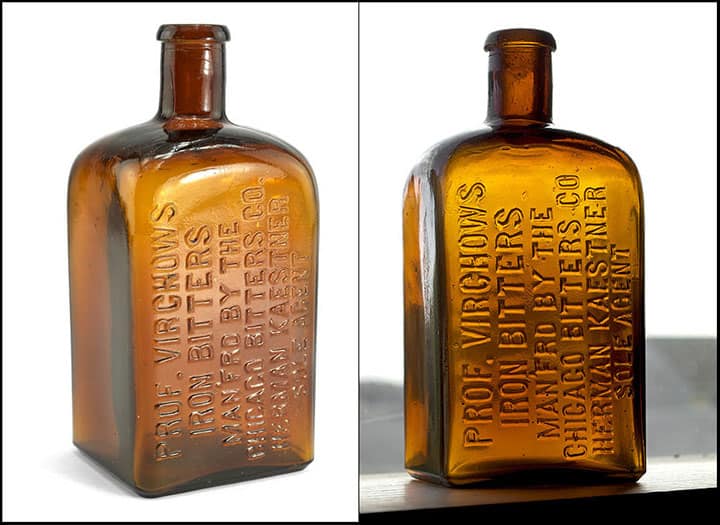
“PROF. VIRCHOWS / IRON BITTERS / MAN’FRD BY THE / CHICAGO BITTERS CO. / HERMAN KAESTNER / SOLE AGENT”, (Ring/Ham, V-23), Illinois, ca. 1880 – 1890, medium amber, 6 3/4″h, smooth base, applied mouth. Cleaned to its original luster but retains some minor imperfections mostly along the edge of the base. Rated as extremely rare, which it must be as none have been sold at auction in the last 25-years! – Glass Works Auctions | Auction 109
Read about another iron bitters: Baltimore’s Iron Bitters – Brown Chemical Company
Herman Kaestner
Herman Kaestner was born in Saxony, Germany around 1822 from parents also from Saxonia. He received his United States citizenship on 03 September 1855 in New York City, N.Y. and moved to Chicago, Illinois to become a pioneer tobacco merchant. Listings for his cigar business can be found in Chicago as early as 1861. He next would lose his property and stock of tobacco in the Great Chicago Fire in 1871. Rebuilding, he again went into the cigar and tobacco business until he moved into the saloon business in 1886 at 609 Wells Street in Chicago. He jumped on the bitters bandwagon around 1890 with his Chicago Bitters Company enterprise and is listed in the bitters business in an 1891 Chicago City Directory. This is why the bottle is extremely rare. He died in 1895.
He named his bitters after Rudolf Ludwig Carl Virchow who was a German doctor, anthropologist, pathologist, prehistorian, biologist, writer, editor, and politician, known for his advancement of public health. He is known as “the father of modern pathology“. I doubt they ever met though they could have met the professor in Germany before he came to United States.
If you look at the bottle mouth, it looks like it has an applied lip. This is odd if it is dated around 1890. Maybe Jeff can confirm this?
Mrs. Kaestner, nee Gebhardt, came over from Germany in a sail boat in the 1850s, and the time consumed in making the trip was seventy-seven days. The trip was accompanied by many perils. (Chicago: Its History and Its Builders, a Century of Marvelous Growth, 1912)
Professor Virchow
Rudolf Ludwig Carl Virchow (13 October 1821 – 5 September 1902) was a German doctor, anthropologist, pathologist, prehistorian, biologist, writer, editor, and politician, known for his advancement of public health. He is known as “the father of modern pathology” because his work helped to discredit humourism, bringing more science to medicine. He is also known as the founder of social medicine and veterinary pathology, and to his colleagues, the “Pope of medicine“.
Born and bred in Schievelbein (Świdwin) as an only child of a working-class family, he proved to be a brilliant student. Dissuaded by his weak voice, he abandoned his initial interest in theology and turned to medicine. With special military scholarship, he earned his medical degree from Friedrich-Wilhelms Institute (Humboldt University of Berlin) under the tutelage of Johannes Peter Müller. He worked at the Charité hospital under Robert Froriep, whom he eventually succeeded as the prosector.
Although he failed to contain the 1847–1848 typhus epidemic in Upper Silesia, his report laid the foundation for public health in Germany, as well as his political and social activities. From it, he coined a well known aphorism: “Medicine is a social science, and politics is nothing else but medicine on a large scale”. He participated in the Revolution of 1848, which led to his expulsion from Charité the next year. He published a newspaper Die medicinische Reform (Medical Reform) during this period to disseminate his social and political ideas. He took the first Chair of Pathological Anatomy at the University of Würzburg in 1849. After five years, Charité invited him back to direct its newly built Institute for Pathology, and simultaneously becoming the first Chair of Pathological Anatomy and Physiology at Berlin University. The campus of Charité is now named Campus Virchow Klinikum. He cofounded the political party Deutsche Fortschrittspartei, by which he was elected to the Prussian House of Representatives, and won a seat in the Reichstag. His opposition to Otto von Bismarck’s financial policy resulted in an anecdotal “Sausage Duel” between the two. But he ardently supported Bismarck in his anti-Catholic campaigns, the social revolution he himself named as Kulturkampf (“culture struggle”).
A prolific writer, his scientific writings alone crossed 2,000 in number. Among his books, Cellular Pathology published in 1858 is regarded as the root of modern pathology. This work also popularised the third dictum in cell theory: Omnis cellula e cellula (“All cells come from cells”); although his idea originated in 1855. He founded journals such as Archiv für pathologische Anatomie und Physiologie und für klinische Medizin (now Virchows Archiv), and Zeitschrift für Ethnologie (Journal of Ethnology). The latter is published by German Anthropological Association and the Berlin Society for Anthropology, Ethnology and Prehistory, the societies of which he also founded.
Virchow was the first to precisely describe and give names of diseases such as leukemia, chordoma, ochronosis, embolism, and thrombosis. He coined scientific terms, chromatin, agenesis, parenchyma, osteoid, amyloid degeneration, and spina bifida. His description of the transmission cycle of a roundworm Trichinella spiralis established the importance of meat inspection, which was started in Berlin. He developed the first systematic method of autopsy involving surgery of all body parts and microscopic examination. A number of medical terms are named after him, including Virchow’s node, Virchow–Robin spaces, Virchow–Seckel syndrome, and Virchow’s triad. He was the first to use hair analysis in criminal investigation, and recognised its limitations. His laborious analyses of the hair, skin, and eye colour of school children made him criticise the Aryan race concept as a myth.
He was an ardent anti-evolutionist. He referred to Charles Darwin as “ignoramus” and his own student Ernst Haeckel, the leading advocate of Darwinism in Germany, as a “fool”. He discredited the original specimen of Neanderthal as nothing but that of a deformed human, and not an ancestral species. He was an agnostic.
In 1861, he was elected a foreign member of the Royal Swedish Academy of Sciences. In 1892, he was awarded the Copley Medalof the British Royal Society. He was elected to the Prussian Academy of Sciences in 1873, and entitled an ennoblement “von Virchow”, but which he declined. [Wikipedia]

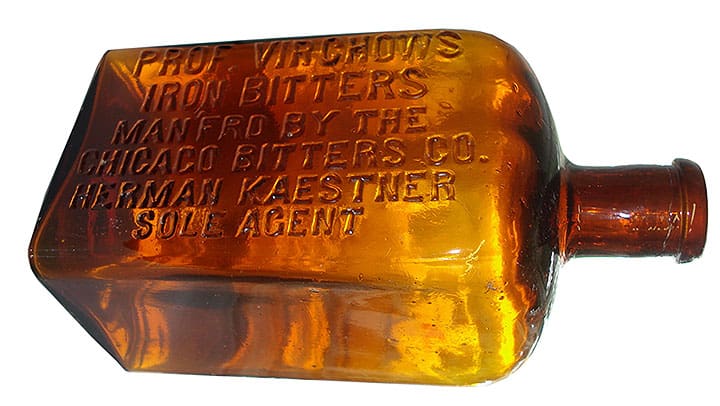
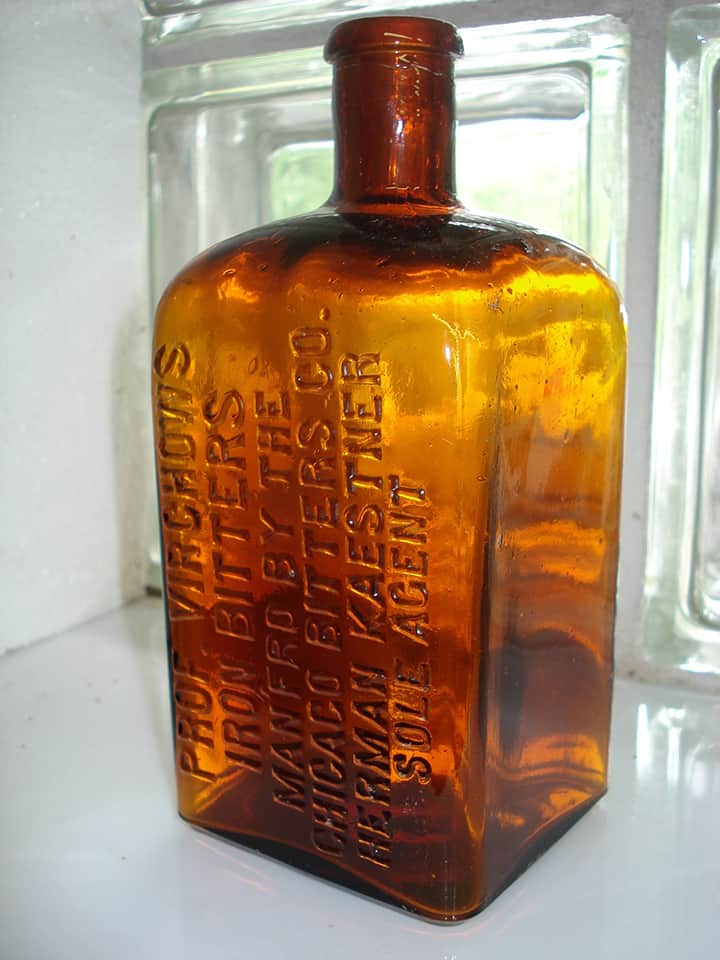
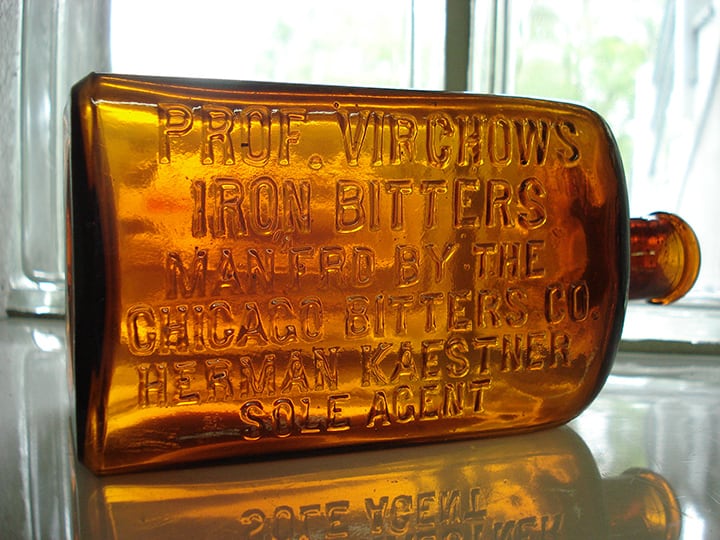
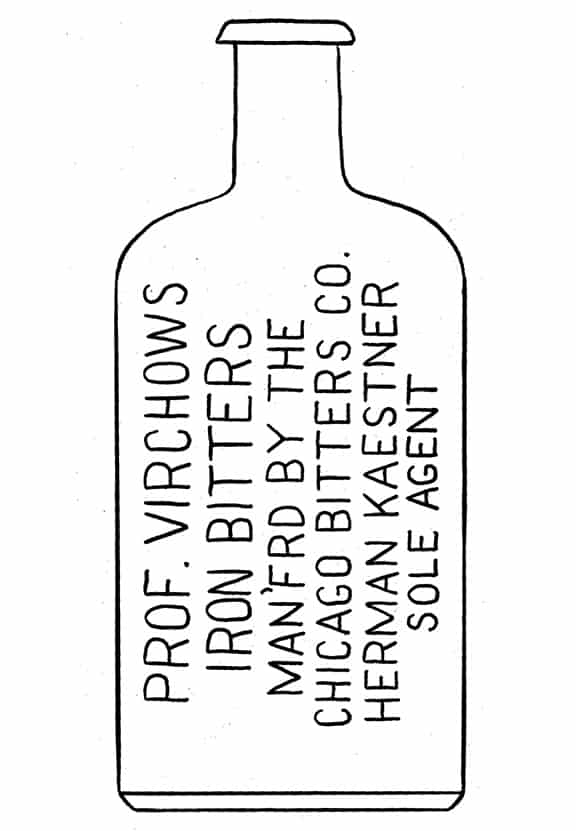
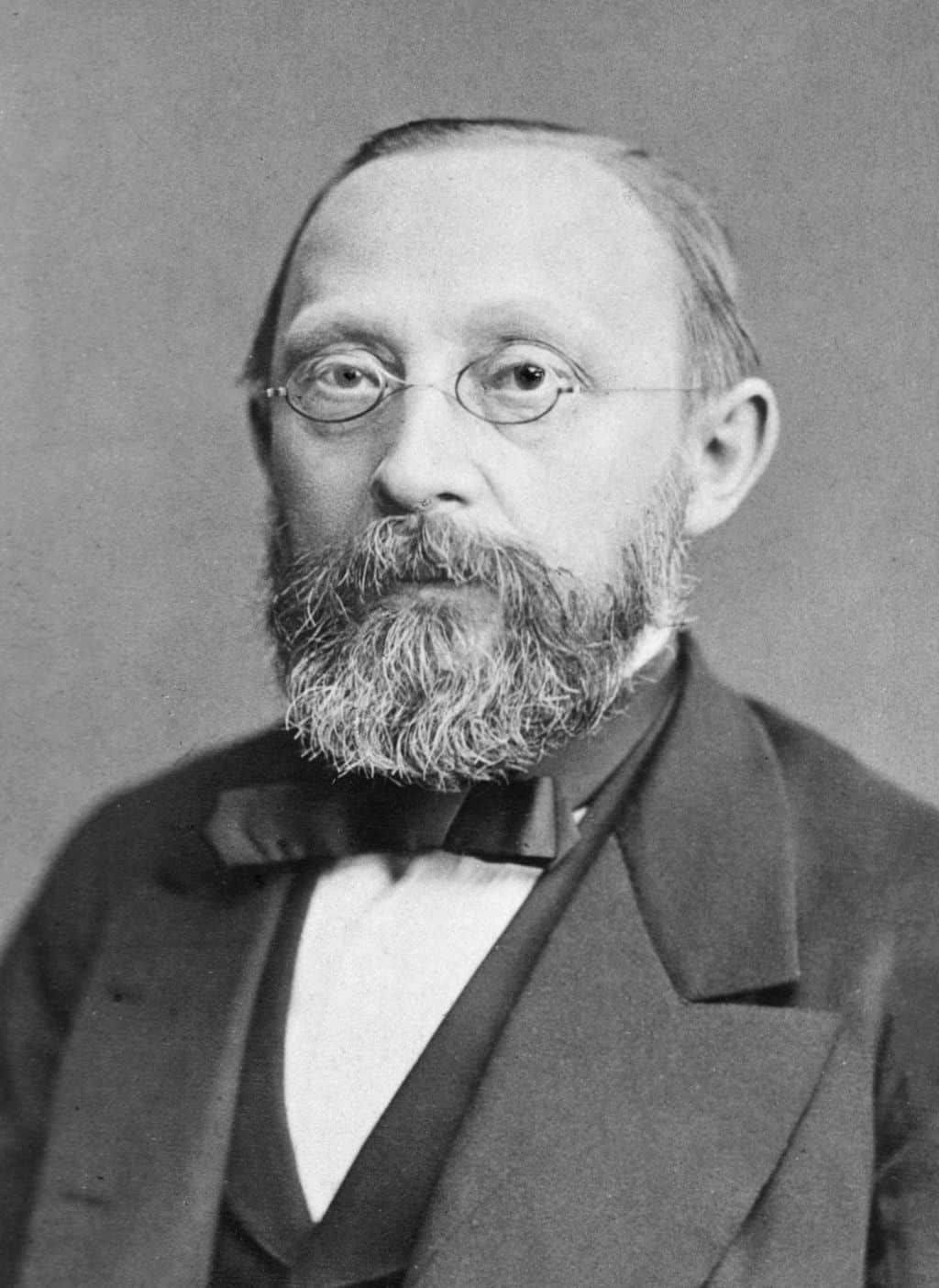







Wow, great amount of add’l info Ferdinand! Always a touch-down when we pass you a ball. And, no the lip is not applied, but tooled.
Froggy